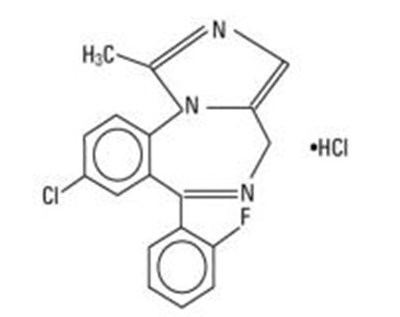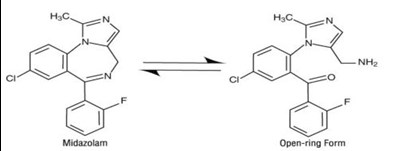Product Images Midazolam
View Photos of Packaging, Labels & Appearance
Product Label Images
The following 19 images provide visual information about the product associated with Midazolam NDC 52584-749 by General Injectables And Vaccines, Inc., such as packaging, labeling, and the appearance of the drug itself. This resource could be helpful for medical professionals, pharmacists, and patients seeking to verify medication information and ensure they have the correct product.
Image1.jpg - Image1

The text describes a graph that shows the percentage of open-ring form in water under different pH values. The percentage ranges from 0 to 50, with the pH ranging from 8 to 60.*
Image10.jpg - Image10
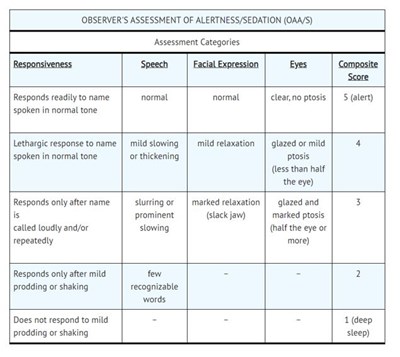
The text describes the Observer's Assessment of Alertness/Sedation (OAA/S) which involves assessing a person's responsiveness, speech, facial expressions, and eyes to determine their level of alertness or sedation. It provides categories and scores for different levels of responsiveness, including being alert, lethargic, responsive only to loud calling or shaking, and unresponsive.*
Image11.jpg - Image11
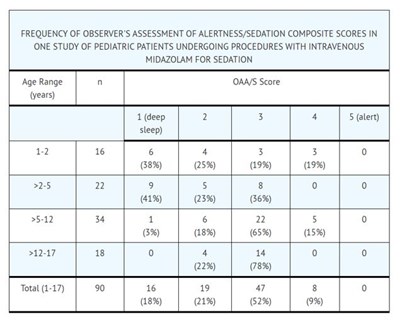
The text describes the frequency of observer's assessment of alertness/sedation composite scores in a study of pediatric patients undergoing procedures with intravenous midazolam for sedation. The table displays the age range, number of patients, and the scores for each category of sedation.*
Image12.jpg - Image12
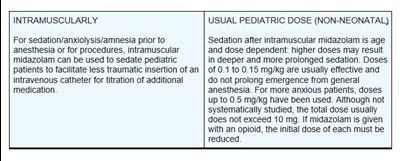
This text provides information about the use of intramuscular midazolam for sedation, anxiolysis or amnesia prior to anesthesia or procedures in pediatric patients. The text specifies that doses depend on the patient's age and weight, with doses of 0.1 to 0.15 mg/kg being typically effective. Higher doses may result in deeper and more prolonged sedation. If given with opioid, initial doses must be reduced.*
Image13.jpg - Image13

This text provides dosage recommendations for midazolam hydrochloride for pediatric patients undergoing sedation, anxiolysis, or amnesia. The appropriate dosage depends on the individual patient and the type of procedure. For all pediatric patients, midazolam should be titrated slowly to achieve the desired clinical effect, and caution should be exercised when administering other medications that may cause CNS depression. Specific dosage recommendations are provided for patients less than 6 months of age, 6 months to 3 years of age, 6 to 12 years of age, and 12 to 16 years of age. Patients who have been premedicated with opioids or other sedatives may require a lower dosage.*
Image14.jpg - Image14
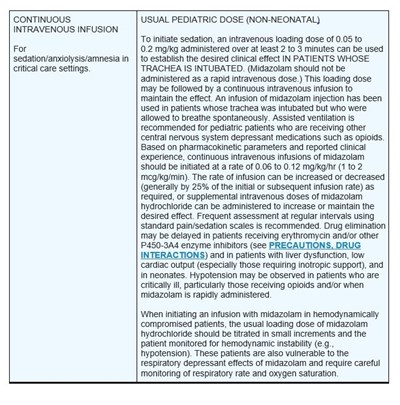
This text describes the use of a continuous intravenous infusion of midazolam for sedation/anxiolysis/amnesia in critical care settings. It provides information on the usual pediatric dose and how to initiate and maintain the therapy. It also recommends frequent assessments and monitoring for potential complications such as drug interactions, delayed drug elimination, and hemodynamic instability.*
Image15.jpg - Image15
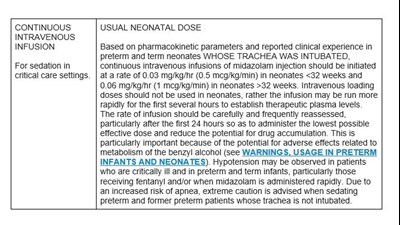
Continuous intravenous infusion of midazolam injection can be used for sedation in critical care settings in neonates whose trachea is intubated. The recommended dose is 0.03 mg/kg/hr for neonates <32 weeks and 0.06 mg/kg/hr for neonates >32 weeks. Loading doses should not be used. The infusion rate should be frequently reassessed to administer the lowest effective dose and avoid drug accumulation. Adverse effects related to metabolism of the benzyl alcohol may occur, and hypotension and apnea are possible in critically ill or preterm infants receiving fentanyl and/or midazolam. Extreme caution is advised when sedating preterm patients whose trachea is not intubated.*
Image16.jpg - Image16

Midazolam Injection, USP (5 mg per mL) is a medication available in a 50 mg per 10 mL Multiple-Dose Vial. Each carton comes with 10 vials.*
Image2.jpg - Image2

This text describes the side effects of a medication which includes headache, pain, induration, redness, and muscle stiffness. The percentages indicate the frequency of each side effect reported during clinical trials. Additionally, there may be local effects at the site of injection.*
Image3.jpg - Image3
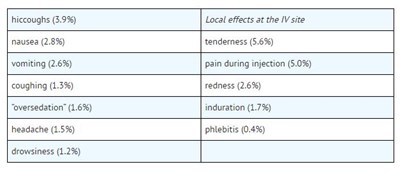
This appears to be a list of possible side effects or reactions associated with an injection at a particular site. Some of the listed effects include hiccoughs, nausea, vomiting, tenderness, pain during injection, coughing, redness, oversedation, induration, headache, phlebitis, and drowsiness.*
Image4.jpg - Image4
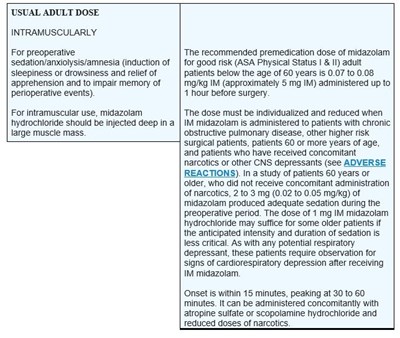
This text provides dosage instructions for midazolam hydrochloride when used for preoperative sedation/anxiolysis/amnesia via intramuscular injection. The recommended dose for good risk adult patients below 60 years old is 0.07-0.08 mg/kg, injected deep into a large muscle mass up to 1 hour before surgery. The dose should be personalized and lowered for patients 60 or older, those with chronic obstructive pulmonary disease, and those who have received concomitant narcotics or other CNS depressants. The onset of midazolam is within 15 minutes, peaking at 30 to 60 minutes. It can be used with other medications, including reduced doses of narcotics.*
Image5.jpg - Image5
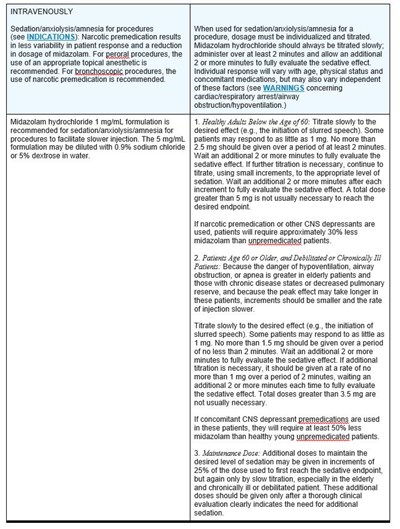
This text is a set of guidelines for midazolam hydrochloride usage during sedation, anxiolysis or amnesia for medical procedures. The drug should be administered intravenously, with dosage and administration rates being individualized, and varied with patient age, physical status, and medications. For oral and branchoscopic procedures, an anesthesia agent and narcotic premedication respectively are recommended. The dosage recommendations change between patients aged below 60 and those above 60, debilitated or chronically ill. The text also outlines the maintenance dose for patients.*
Image6.jpg - Image6
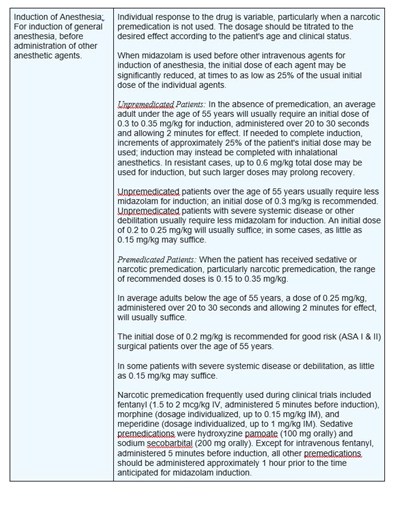
This is a set of guidelines for administering midazolam as a primary drug for inducing general anesthesia. The optimal dosage of midazolam for induction of anesthesia can vary depending on factors like the patient's age, clinical status, and previous use of narcotic premedication. Unpremeditated patients usually require an initial dose of 0.3 10 0.35 mg/kg for induction. In contrast, pre-medicated patients with narcotic premedication usually require a dose of 0.15 10 0.35 mg/kg. However, when midazolam is used before other anesthetics, the dose of both agents should be lowered, and the individual dosage should be carefully regulated. This text provides detailed instructions for using midazolam safely and effectively during induction of general anesthesia.*
Image7.jpg - Image7

Injectable midazolam hydrochloride can be used during anesthesia maintenance and surgical procedures as a component of balanced anesthesia. It is recommended to provide effective narcotic premedication in such cases. The dosage should be given incrementally, approximately 25% of the induction dose, in response to signs of lightening of anesthesia, and repeated as necessary.*
Image8.jpg - Image8
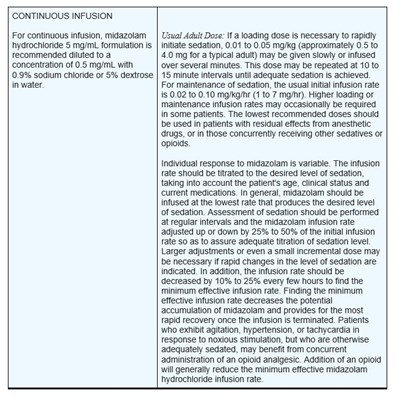
This text provides dosing information for midazolam hydrochloride 5 mg/mL for continuous infusion. The recommended dilution is provided, along with usual adult doses for loading and maintenance infusion rates. The dosage should be adjusted based on the patient's response to the medication, including their age, clinical status, and current medications. Infusion rates should be increased or decreased to achieve the desired level of sedation and should be decreased over time to prevent accumulation of the medication. The addition of an opioid may decrease the minimum effective midazolam hydrochloride infusion rate.*
Image9.jpg - Image9

Pediatric patients generally require higher dosages of midazolam hydrochloride on a mg/kg basis than adults. Dosages may vary depending on the age of the patient and may require close monitoring. Ideal body weight should be used to calculate dosages for obese pediatric patients. When used in combination with opioids or other sedatives, there is an increased risk for respiratory depression, airway obstruction, or hypoventilation. Healthcare practitioners should follow professional guidelines for pediatric sedation appropriate to their situation and closely monitor patients.*
* The product label images have been analyzed using a combination of traditional computing and machine learning techniques. It should be noted that the descriptions provided may not be entirely accurate as they are experimental in nature. Use the information in this page at your own discretion and risk.
